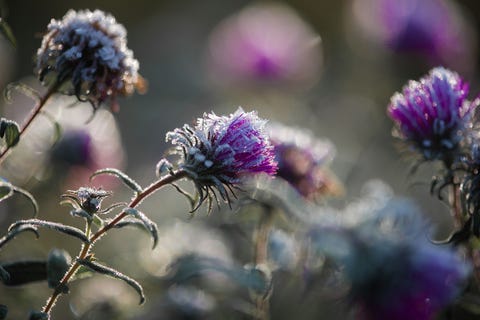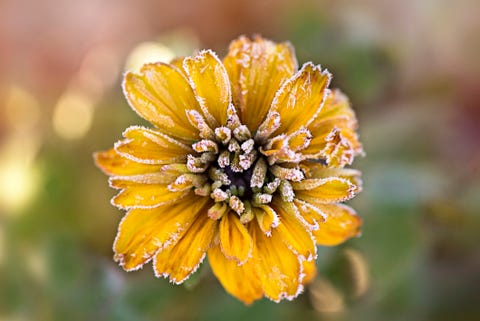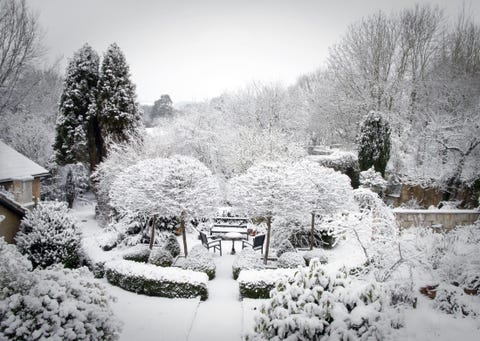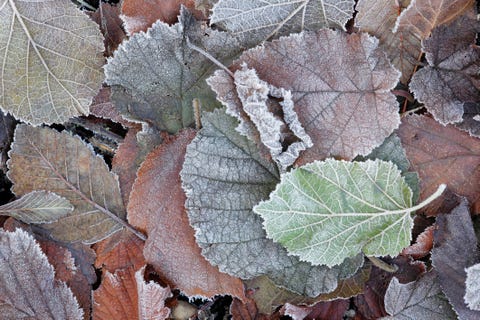How Can Cold Weather Affect Plants In A Garden

Claire Plumridge Getty Images
The cold snap doesn't just impact our native wildlife. Frost and snow can also wreak havoc on our gardens causing outdoor plants and shrubs to stop growing.
As Chris Bonnett from GardeningExpress.co.uk explains: "Hot and cold weather can both affect a plant's heath. Chilly temperatures freeze the cells in a plant causing damage and interrupting the way nutrients and water flow around it.
"Growth will stop, and some plants will even become dormant to avoid as much damage as possible."
But there are some ways you can protect your plants from the freezing temperatures.
"Whether the cold air harms your plants depend on how long the low temperatures remain, where your plants are positioned and the steps you take to protect them," Chris says.
"Even the simplest measures can help. Covering tender plants overnight with an upturned bucket or flower pot is a very quick and easy step to take, as is covering larger shrubs with an old bedsheet."
Here, Chris' top tips for protecting your plants when the temperatures drop.

Zelma Brezinska / EyeEm Getty Images
1. Watering your plants
Keep watering your plants during the cold weather, but do it in the middle of the day when temperatures are a little warmer. Plants still lose moisture from their leaves, and may be unable to draw up water from their roots if the soil is frozen.
2. Plant position
If you have plants in pots, move them to a sheltered spot and wrap the sides of the pots. Bubble wrap or a fleece plant wrap are both good to use.

Jacky Parker Photography Getty Images
3. Protecting tender plants
Cover tender plants during frosty conditions with an upturned bucket or flower pot. This takes just minutes but can make a huge difference.
4. Protecting shrubs and trees
Too big for an upturned bucket? Cover larger shrubs and trees with an old bedsheet, a large piece of fabric, or frost cloths and fleece covers.

triffitt Getty Images
5. Mulch and straw
For a short chilly snap, cover the soil around plants with mulch or straw. As the temperature begins to rise, take it away.
6. Use a windbreak
Try creating a windbreak for larger plants. This will give them some protection as icy winds sweep in.

temmuzcan Getty Images
7. Do not bring plants indoors
Don't be tempted to bring your favourite plants inside during the cold weather. The sudden change in temperature can kill them.
8. Snowy conditions
Snow can act as an insulator, protecting plants from the cold and frost. After heavy snow, shake excess snow from large trees, hedges and bushes to prevent them becoming disfigured from the extra weight. Avoid walking on a snow-covered lawn as it will damage the turf underneath.

Christian_Cam Getty Images
9. Don't panic
If your plants do show signs of damage, don't panic. Wait until the weather warms up and new shoots begin to come through before you start snipping. Prune out the damaged parts once you see the new growth.
This content is created and maintained by a third party, and imported onto this page to help users provide their email addresses. You may be able to find more information about this and similar content at piano.io
How Can Cold Weather Affect Plants In A Garden
Source: https://www.countryliving.com/uk/homes-interiors/gardens/a25974618/how-to-protect-plants-from-cold-weather-frost/
Posted by: harrisblapeneve.blogspot.com

0 Response to "How Can Cold Weather Affect Plants In A Garden"
Post a Comment